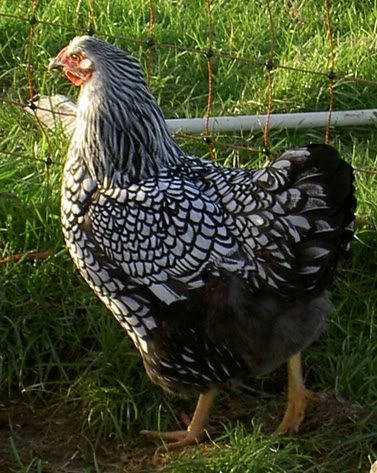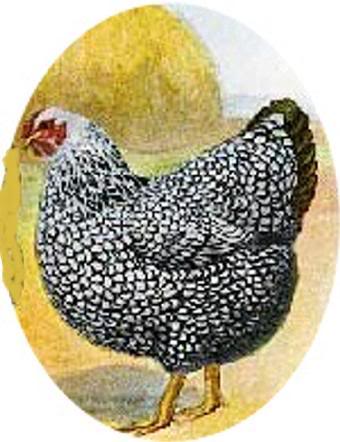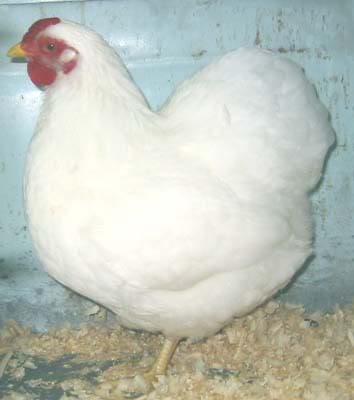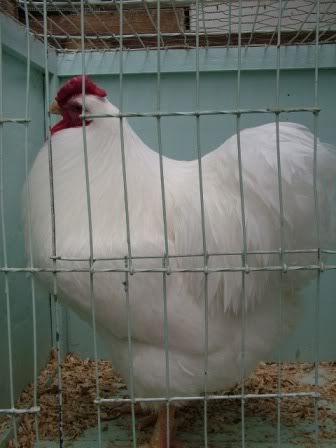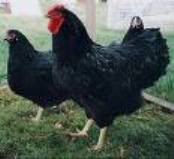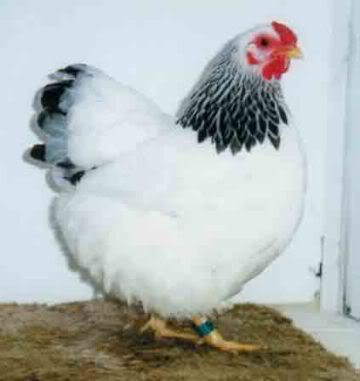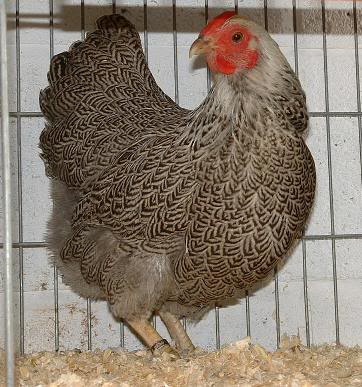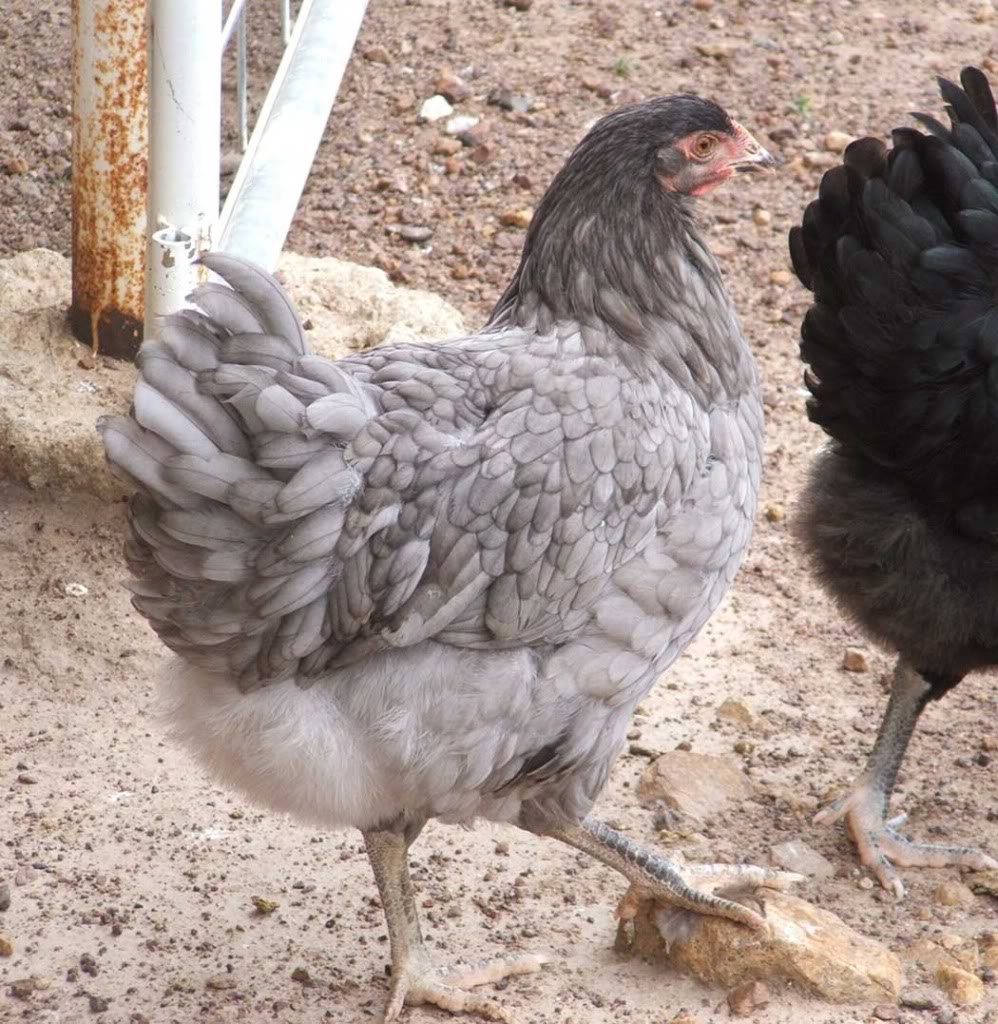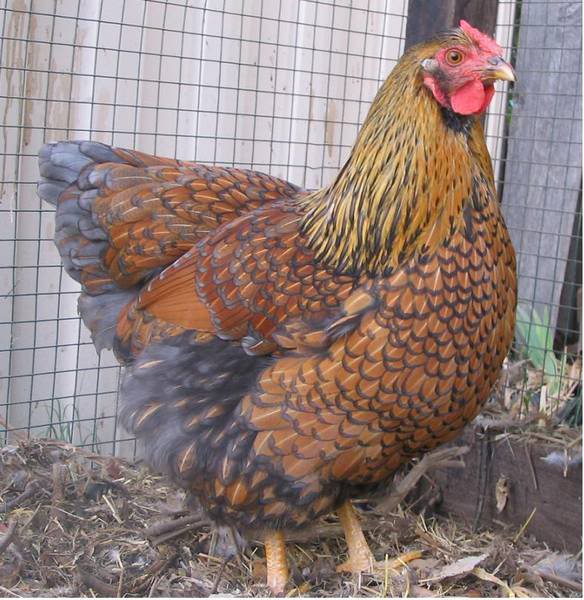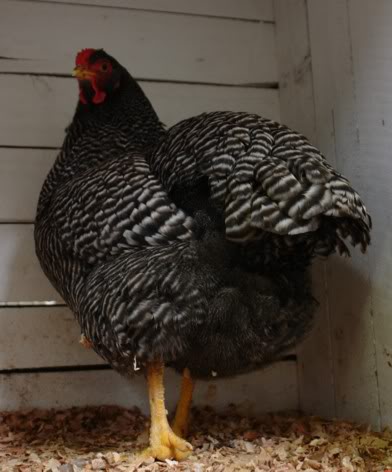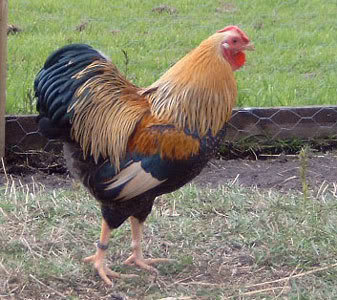Wyandotte - Breed Feature
Poultry Matters Forum moved to: www.poultrymatters.com :: Poultry Related :: Poultry breeds, breeding & showing
Page 1 of 1
 Wyandotte - Breed Feature
Wyandotte - Breed Feature
rwood wrote:The Wyandotte Breed
The Wyandotte is a docile dual purpose breed of chicken originating in the United States and is renowned for its round curvy body, it good size and healthy vigor. The Wyandotte is a breed that suits both free range and confinement in a run and is kept for both eggs and meat. They appear in a wide variety of color patterns, and are popular show birds. Popular pronunciation is Y-an-Dot or Wine-dote. Below is the classic Silver Laced Wyandotte.
Description
The Wyandotte is described as the bird of curves, with each of the curves being clearly defined. They are therefore quite round and are what you would call a “Good Sized Bird”. They have a rose comb and clean yellow legs. The feathering of the Wyandotte is somewhat looser and softer than that of the other breeds in the American class and is also more compact and rounder in form than other the other breeds such as Rhode Island Red and the Plymouth Rock, due to Cochin blood in its original makeup.
Behavior
They tend to be quite friendly, healthy and are not flighty, so make good pets for people and are one of the best backyard chooks to keep. They are also vocal, uttering soft clucks on a regular basis and are particularly eager to tell everyone that they are about to lay an egg. They are considered good broodies and in my experience they are likely to go broody at least twice a season, and are very strong sitters and good mothers.
History of the Breed
The Wyandotte breed name comes from the town of Wyandotte (Michigan USA). The name is pronounced Y-an-dot or Wine-dote (the town at least is pronounced Y-an-Dot), which is actually derived from a once numerous tribe of North American Indians.
The first examples of the breed appeared in 1870s and were of the Silver Laced Variety. The four men credited with the development of the Silver Laced Wyandotte during the 1870s were H.M. Doubleday and John Ray of New York State, L. Whittaker of Michigan, and Fred Houdlette of Boston, Massachusetts. The Silver Laced Wyandotte was admitted to the American Standard of Perfection in 1883. The description of the type for this variety became the type of the other Wyandotte varieties which followed. The Silver Laced variety was a dual-purpose bird, producing brown-shelled eggs and yellow skinned meat. At the time they were exhibited and judged for type and plumage as well as egg production. Early records reveal they held their own in egg laying contests. Fred Houdlette wrote about 25 years later that the form or shape of the Wyandotte was his own idea and that he had the fight of his life to get his collaborators to agree to it.
Utility Characteristics
Eggs - Hens will lay around 200 eggs a year with an exceptional hen laying around 240 eggs a year. The eggs are brown or tinted.
Meat - The hens weigh around 2.7 kg (6 pounds) and the cocks weigh around 3.5kg (8 1/2 pounds). Bantam Cock = 1020g, Bantam Hen = 850-960g
Breeding - Wyandottes are easy yo breed most of the time. Some colours do need the plumage trimmed around there vent as they are more “fluffy”, particularly in the whites. Wyandottes are very good mothers and go broody often . It is worth noting that the Wyandotte has a Pullet Line and a Cockerel Line, so the standard effectively calls for two different genetic make ups. The picture below shows the difference between the PB and CB lines. (CB on the left)
Cost - Wyandotte can cost from anywhere from a few dollars for pets or up to a few $100 each for show birds.
Colours
There are a large number colour variations including Silver laced, Gold Laced, white, black, buff, Columbian, partridge, penciled, Blue Laced Gold Blue Laced Red, Buff laced, and Silver Pencilled. Other colours bred in Australia include Barred, Cuckoo, Crele, Reds, Piles, Blue Partridge, Wheaten, birchen, brown red and duckwing.
.
Silver Laced: The silver laced Wyandotte has white feathers with black edges to every feather, an effect called lacing. The tail is black and they should have yellow legs. The silver laced was developed in New York state in the early 1870s and was admitted to the standard in 1883. The silver laced Wyandotte was the base for all other colors. Its origins are somewhat uncertain. Some writers suggest that the Dark Brahma was used in the early crosses, while others refer to a breed called the Chittagong, which had Malay, Shanghai or Cochin, as well as the Dorking in its background. Writers tend to agree that the other breed used to create the Wyandotte was known as the Silver Sebright (not the bantam fowl by the same name). This breed appears to have had a laced plumage pattern.
The Silver Laced Wyandotte variety is unique for its black and white color pattern of open white ovals laced with black. While the female has lacing on breast, wings, lower tail, and body plumage, the male has the lacing only on breast and under body plumage, with two rows of laced feathers across the wings. The male and female have white lacing in the hackle plumage. The male also has the white lacing in the lower tail and saddle plumage. Both male and female have solid black main tail feathers. The male also has white wing bows.
Golden Laced: The golden laced Wyandotte is a golden color with black around the edge of every feather and black tail. Joseph McKeen of Wisconsin was the originator of the Golden Laced Wyandotte. In 1880 he crossed Silver Laced Wyandotte females with a large "Black Red" patterned fowl called the Winnebago. The variety was admitted to the American Standard in 1888 and soon was regarded as being equal in type to the Silver Laced variety. The Golden Laced is the same pattern as the Silver Laced, with a gold oval laced in black.
Buff: The buff is a buff color all over. A buff is like a ginger orange color. The first Buff Wyandottes were light colored Rhode Island Reds. These were lacking in type and off in color. However, they laid the foundation for the true Buff Wyandotte that was correct in breed, type, and color. Buff's were admitted to the Standard in 1893. It is a rich buff with yellow shanks. The male is somewhat brighter in buff color than the female.
Buff Laced: The buff laced is buff but with white around the edge of the feathers.
White: The white is white all over. The whites came from a sport out of the Silver laced and in Australia at least, are the most comonly seen variety next to the SIler Laced, particularly in Bantam. They are also considered the best type of the many colours avaiable. This variety was standardized at the same date as the Golden Laced, in 1888. No single originator was credited with its development, although Fred Houdette, George Fowler and B.N. Briggs were the men chiefly associated with it. The White Wyandotte in the 1890s and early 1900s became one of the popular Wyandottes on the farm and at the poultry shows.
Bantam
Large
It is my opinion that the White Wyandotte has become too rounded and is not the standard, even though judges and others think this is what a Wyandotte is. You look at all the images of old fashioned wyandottes (particularly silver) and they are nothing like that Large above. To me, that is a Cochin without feathered legs. MHO.
Black: The black is black all over. The Black Wyandotte is another true Wyandotte as it, like the White, is a sport of both the Silver Laced and the Golden Laced varieties. Blacks were admitted to the American Standard in 1893. The earliest breeders were F.J. Marshall and F.M. Clemens of Ohio, who began developing them in 1885. This variety has not experienced the popularity in America that they have in England, Belgium, Holland and Germany. The Black Wyandotte is solid black in color with yellow shanks. The male has a green sheen when seen in bright sunlight.
Columbian: Columbian is white, but with a black tail, black wing tips and the neck is mainly black with some white. Columbian Wyandottes were first exhibited at the Columbian Exposition of the 1893 World's Fair held in Chicago. This variety was produced by crossing a White Wyandotte and a Barred Plymouth Rock.
Partridge: A red color but with three black stripes, meeting at the middle of the feather and then going outwards at an angle in the hen, and the cock looks like a typical farmyard cock. The main tail feathers are black in both male and female. The male is marked as the Red Jungle fowl, only darker in color.
Silver Pencilled: Like the partridge, but with a silver undercolor in the hen and the cock is a white color but with bits of black in there until the tail and the wing which are black. An interesting cross breeding brought about the Silver Penciled Wyandotte. They were produced by the blending of two strains; one, a Partridge Wyandotte - Dark Brahma cross, the other, a cross of Silver Laced Wyandotte and Silver Penciled Hamburgs.
Blue: The hen is blue all over but the cock is black with the tail and wing blue on some birds. The factor for blue plumage is found in a number of breeds, so it is a matter of crossing one of these with the Black Wyandotte to develop the blue variety. This blue is that of the Blue Andalusian, which is bluish slate with each feather having a sharply defined lacing in black.
Blue Laced Gold / Red: The blue laced gold is as per the Gold Laced, but with blue lacing instead of black. The gold contains a diluter gene, diluting Red to Gold. The red is a red ground colour, lacking the diluter and also having some red enhancing genes. The Red is not present in Australia.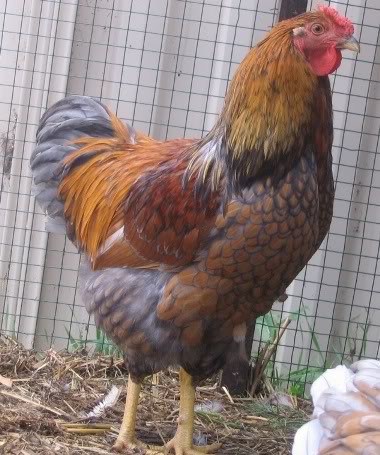
They are my Cockerel and Pullet above, I am so proud.
Buff Columbian: Like the Columbian except buff.
Red: The red wyandotte is a dark red/brown all over. The oz standard calls for a bird with black stripes in the neck hackle and a black tail, very much like a Red Columbian.
Barred: The barred, in both genders, has feathers which have black and white stripes across the width of the feather, all over the body.
Mille Fleur: The mille fleur Wyandotte is a dark brown color with black crescents with white spots on the tips however this is not a standardised colour in Oz.
Crele – See Picture
Duckwing (GOlden) from Europe
Wyandotte type
The ideal Wyandotte type would include; Comb - Rose, Beak - Short and well curved, Face - Smooth and free from small feathers, Eyes - Full and round, Wattles - Moderately long and nicely rounded with no folds or wrinkles, Ear Lobes - Oblong, smooth, and about a third the length of the wattles, Head - Short and round with a broad crown, Neck - Short and well arched, Back - Broad, but medium in length with flat looking shoulders, Tail - Short, well spread at the base, and carried at a 45 degree angle, Wings - Medium in size and well folded with no drooping, Breast - Broad, deep, and round, Legs - Set well apart and straight, Toes - Well spread with four on each foot. The below picture is a good one I believe that shows the type required.
More comments on Type for the enthusiast.
The Wyandotte is described in the American Poultry Association Standard of Perfection as a bird of curves. Wyandottes are well balanced, which means that the legs are squarely set under the center of the bird. The body is carried in a horizontal position on stout yellow shanks. Looking at the bird from the front, the legs are well spread and fairly heavy in bone. The shank is medium in length and the full hock can be seen. The breast is broad and full and the back is of medium length. The Wyandotte female shows a slight cushion, but not to the extent of appearing Cochin-like.
Another unique characteristic of the Wyandotte is its good breadth of skull. In fact, it has a comparatively broader skull than the other breeds in the American class. The head has a bold appearance emphasizing the cobby appearance of the whole bird. The crowning feature is a rose comb, which follows the head and ends at the back of the head in a neat leader (the spike). The neck is short, well curved and well furnished with abundant hackle feathers. The hackle is well rounded so as to carry out the unbroken line of head and neck. The back shows a short space above the shoulders, which are level and then rise towards the tail, blending smoothly and evenly. There is no break where the back leaves off and the tail begins and for this reason the Wyandotte often appears to have a much shorter back than is really the case. The breadth of the back is carried out in the breadth of the body so that the sideline of the fowl as viewed from above appears smooth or even without indentations.
The wings are carried level and not too long, They are folded snugly and held up in place. The tail is fairly short and well spread. At the base, however, the tail is well spread. The sickle feathers of the male are to be pliable and of medium length so that they curve nicely over the ends of the main tail feathers, giving the tail a short cobby appearance. The top of the tail is on a level with the junction of the head and neck, which lines up with the earlobe.-
quoted from HERE with kind permission of the author, R. Wood.
 Similar topics
Similar topics» Sussex Breed Feature
» Breeds in the first ed of the Australian Poultry Standards - INDEX of BREED FEATURE PAGES in Construction
» Hendersen's Chicken Breed Chart
» Breeds in the first ed of the Australian Poultry Standards - INDEX of BREED FEATURE PAGES in Construction
» Hendersen's Chicken Breed Chart
Poultry Matters Forum moved to: www.poultrymatters.com :: Poultry Related :: Poultry breeds, breeding & showing
Page 1 of 1
Permissions in this forum:
You cannot reply to topics in this forum|
|
|


